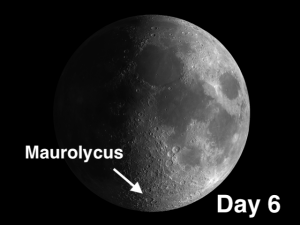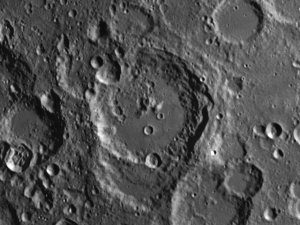The week of December 18 – 24 takes us from just past New Moon to Day 6. This week we will highlight the crater Maurolycus, viewable on Sunday evening.
 Maurolycus: [SE/P11] Let us venture briefly into a region where angels fear to tread, the lunar Highlands. Plunge in and look for the crater Maurolycus. Although the area looks confusing, Maurolycus will be the largest and most conspicuous crater in this sector. It is a breathtaking sight under an early morning Sun and should not be missed.
Maurolycus: [SE/P11] Let us venture briefly into a region where angels fear to tread, the lunar Highlands. Plunge in and look for the crater Maurolycus. Although the area looks confusing, Maurolycus will be the largest and most conspicuous crater in this sector. It is a breathtaking sight under an early morning Sun and should not be missed.
 Maurolycus displays a rich diversity of different types of features. How many can you see? The central mountain peaks are so tall that they are illuminated long before the Sun finds its way to the dark floor. Also notice how Maurolycus overlaps a smaller unnamed crater on its southern border. This flies in the face of the rule that says younger craters are usually smaller than their older bretheren.
Maurolycus displays a rich diversity of different types of features. How many can you see? The central mountain peaks are so tall that they are illuminated long before the Sun finds its way to the dark floor. Also notice how Maurolycus overlaps a smaller unnamed crater on its southern border. This flies in the face of the rule that says younger craters are usually smaller than their older bretheren.
OF ADDITIONAL INTEREST IN SPACE THE WEEK OF DECEMBER 18-24:
Sirius will rise around 7:30 PM, depending on where you are. As it rises, it has been known to twinkle vividly in different colors. Use binoculars to increase the effect.
Thursday, December 21st, the Winter Solstice, is the shortest day of the year in the Northern Hemisphere, and, historically, is a day of great importance. Ancient peoples recognized that if the movement of the Sun towards the south did not cease and reverse itself, they would be doomed, so one of the most important functions of the chief priests of various cultures was to predict when the solstice would happen, and it was a day of great celebration. In one pagan culture, early Roman Catholic priests were astonished to learn that centuries before the birth of Jesus, the chief priest would emerge on the day of the solstice and announce, “The Virgin hath brought forth, let us rejoice!” They were referring, of course, to the virgin of the skies bringing forth a new-born sun, but this meaning was lost on the Roman Catholic priests who were thoroughly perplexed. One interesting spin on this announcement was, “The devil hath quite surpassed himself in that he hath reversed the normal sequence of events.”
======================
It is highly recommended that you get a copy of Sky and Telescope’s Field Map of the Moon, the very finest Moon map available for use at the telescope. It is available for $10.95 at www.skyandtelescope.com and on Amazon. All features mentioned in this blog will be keyed to the grid on the Field Map and will look like this: Plato: [NW/D9]
Credits:
Courtesy of Gray Photography of Corpus Christi, Texas
Lunar photos: NASA / USGS / BMDO / LROC / ASU / DLR / LOLA / Moon Globe. Used by permission
- Rupes Cauchy: A Best Known Fault on the Moon - July 22, 2024
- Moon Crater Schickard – Crater Floor has Stripes - July 15, 2024
- Moon Craters Langrenus and Vandelinus - July 8, 2024